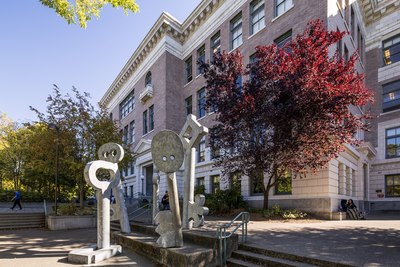|
Subscribe / Renew |
|
|
Contact Us |
|
| ► Subscribe to our Free Weekly Newsletter | |
| home | Welcome, sign in or click here to subscribe. | login |
Construction
| |
 |
August 1, 2019
Reducing K-12 carbon footprints through reuse

By KRISTIAN KICINSKI BASSETTI ARCHITECTS |
In 1986, when school districts across the country were razing historic schools in favor of building new ones, the citizens of Seattle held hands and surrounded Franklin High School declaring that their school would not be torn down.
Seattle Public Schools listened and Bassetti Architects was brought on board to restore the landmark. Franklin High School’s rehabilitation became a national standard, inspiring districts throughout the country to carefully consider the preservation of their historic schools.
The project received numerous design and preservation awards, protected a community asset and revitalized the school’s educational program within the historic shell.
What no one knew in 1986, however, is that by choosing to modernize the school, the project was also supporting the planet above and beyond the sustainable features that were incorporated into Franklin’s redesign.
Since that time, Seattle Public Schools has revitalized more than two dozen historic schools and, although it has become increasingly apparent that these schools are more than capable of meeting the vast programmatic necessities associated with 21st-century learning, what about sustainability?
In the throes of climate change, can historic schools even begin to measure up to the green features being incorporated into new buildings?

They can, indeed.
In 2011, the National Trust for Historic Preservation conducted a study on the embodied energy of existing versus new buildings called “The Greenest Building: Quantifying the Environmental Value of Building Reuse.” This document revealed that K-12 replacement projects can take up to 75 years to reach the carbon equivalency of an existing historic building.
After decades of research, there is now enough data to conduct a more conclusive life-cycle assessment of historic K-12 schools to inform the direction of our projects. This was the case with the current modernization of Benson Polytechnic High School in Portland.
After nearly 40 years since a major capital bond measure had been approved and, facing a growing backlog of deferred maintenance and inadequate facilities, Portland Public Schools set about creating a long-range plan in 2012.
With more than 40 landmarked or potentially landmarked schools built before 1950, this plan set priorities for the design teams who would work on these historic schools:
• Balance potential life-cycle savings of new construction with the embodied energy investment in exiting buildings.
• Respect and preserve historic elements unique to neighborhoods.
• Salvage and reuse high-quality materials.
Life-cycle assessment
Portland Public Schools also wanted to evaluate the life-cycle embodied energy impacts of rehabilitating their schools instead of replacing them.
With this imperative, Bassetti used a life-cycle assessment to evaluate the embodied energy impacts of the design for Benson. Coupled with the program requirements and first-cost analysis, the life-cycle assessment helped the design team determine the efficacy of restoring areas of the historic building. To do this, Bassetti used methodology recommended by the University of Washington’s Carbon Leadership Forum.
For the study, we looked at four scenarios. In each one, we assumed a building lifespan of 75 years, consistent with the National Trust’s study:
A surprising finding
Our initial result was as expected, the proposed design generates approximately 12,000 metric tons of CO2e (the CO2 equivalent), versus about 24,000 metric tons for the replacement and baseline scenarios.
What does saving 12,000 metric tons of CO2e mean? To put some context to that number, we would need to plant 196 acres of trees and let them grow for 75 years to offset the carbon from the proposed design. For the replacement scenario, 355 acres of trees are required. For automobiles, 12,000 metric tons is the equivalent of saving 1.3 million gallons of gasoline and, for home energy use, it equates to a savings of 1,437 homes for one year.
To get a fuller picture, we combined the initial embodied carbon from construction with the footprint of operational energy over 75 years. When we did this, we encountered a few surprises. First, it appeared that the initial embodied energy was quickly dwarfed by the operational energy.
But what about the significant impact of construction?
We looked at this ratio over two timescales. A 20-year period showed that with the proposed design, construction accounted for about 33% of the total impact. For the replacement scenario, embodied energy was about 50% of the total. When looking at 75 years, the proposed and replacement scenarios showed 12% and 23%, respectively, for embodied energy.
The second finding surprised us. When we compared the proposed design to the existing building, we found that because the current energy use is already quite low it would take 20 years before the total footprint of the proposed design becomes less than the amount needed to continue to operate the existing building.
What’s more, the complete replacement option didn’t have a lower footprint until 40 years. This suggests that the often-held assumption that building new, energy-efficient buildings to replace aging ones as a way of reducing impact isn’t necessarily correct. This corroborates the findings in the previously mentioned study by the National Trust where the total footprint of a historic building became less than the footprint of a new one.So where is the biggest impact coming from in construction? The life-cycle assessment shows that concrete accounts for more than half of the embodied carbon — and that’s for a steel-frame building. Reducing concrete in construction reduces a project’s overall footprint.
We also looked at the power sources for operational energy. For the sake of the data analysis, the makeup of the energy sources for the project were assumed to remain constant for 75 years.
However, we know that isn’t accurate since Portland, along with many cities across the country, plans to increase the use of renewable energy and phase out fossil fuels.Currently renewables account for about 24% of Portland’s electricity, coal is 15% and natural gas is 28%. What if Portland transitions to cleaner power over the next 75 years? For comparison we ran the calculations again, this time using Seattle City Light’s power mix as the operational energy. Seattle boasts the greenest electricity in the country, with 92% coming from hydroelectric and renewable sources.
Now, the percentage of embodied footprint versus operational footprint is different. Over the 20-year timeframe, construction accounts for 59% of the project’s total footprint and a whopping 75% in the case of the replacement option. At the 75-year mark, construction impacts are still at 28% and 46% of the proposed and replacement options, respectively. So, as Portland’s energy sources get cleaner over time, the upfront impacts from construction become a larger factor.By completing the life-cycle assessment, Bassetti was able to demonstrate three critical lessons:
Kristian Kicinski is an associate principal at Bassetti Architects and the firm’s director of sustainability.
Other Stories:
- At successful schools, learning happens everywhere
- As classrooms evolve to meet changing needs, the furniture should too
- How safety by design makes school projects safer from start to finish, and beyond
- Tacoma takes a chance on progressive design-build
- Can a building help kids cultivate personal relationships?
- New middle school furthers Seattle Academy’s urban evolution
- When it comes to renovations, seeing is believing
- A designer’s day as a kindergartner
- Tsunami-safe elementary a model for coastal communities
- WA public schools: Top 10 project awards for 2019
- Concrete systems help schools achieve net-zero goals
- Tacoma school has flexible spaces that invite learning, community


